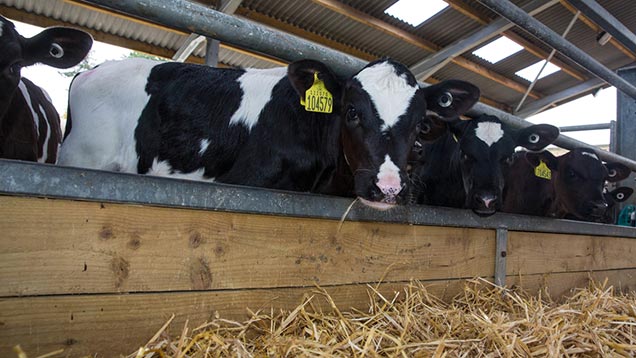Livestock Event 2015: Focus on dairy beef calves can add £300 a cow
 © Tim Scrivener
© Tim Scrivener Dairy beef calves have huge potential to clear more profit in their first two weeks of life than any dairy cow could in the same time.
That is according to Westpoint Vets director Rob Drysdale, who said it is time to stop viewing dairy beef calves as a by-product and start treating them as the fifth quarter of the dairy cow, adding about £300 to the total output of each animal.
“We’re trying to get farmers to change their habits. By looking more strategically at their calf crop there is value to be added in beef from dairy.
“The value of a beef-cross calf can be more than £300 at 10-14 days old.
“By looking at black and white bull calves as an income stream, plus selective breeding using sexed semen, more income can be derived from the same number of calvings.”
To achieve this, Mr Drysdale recommended using a few simple rules, but crucially sticking to them.
This should avoid too many dairy replacements being bred, leaving more to be bred to higher-value beef cross than dairy semen, something he said is a common issue.
“Most farmers are concerned they won’t have enough replacements so put more to dairy.
“Put the milking heifers, milking second calvers and young heifers to sexed semen, followed once by conventional semen and then to beef.
“In reality that’s enough to breed all your replacements and the genetic gain will be better with youngstock,” he added.
Mr Drysdale believes AI offers more trialled and tested bulls, plus breeding to specific named sires could be worth £20-30 a calf compared with other bulls of the same breeds.
And while using a stock bull to sweep or breed problem animals can help with pregnancies in the dairy herd, farmers should bear in mind areas such as proven calving ease and daily liveweight gain that high EBV bulls often carry, he said.
To optimise profit when rearing dairy beef calves, Mr Drysdale suggested selling black-and-white bulls as weanlings, cross breeding with Flekvieh or Norweigian Red to carry more value and looking after them well by feeding good-quality colostrum.
“Time, effort and attention to detail is needed to get the best from calves.
“Training is needed and monitoring programmes can really help.”
Are the sucklers finished?
With 57% of all UK beef coming from dairy, Mr Drysdale believes suckler herds may be at risk in the near future.
“Where the suckler cow really loses out is carbon footprint and sustainability – these two counts stand against single suckled beef when compared with dairy beef.
“Cost of running suckler beef compared with dairy beef means the required income per head needs to be considered carefully.
“Feed conversion is also a factor here for the future,” he said.
However, Mr Drysdale does believe there will always be a place for the suckler herd in particular situations to manage land and produce high-quality, high-value beef that will be demanded in restaurants.
Read more news from the Livestock Event 2015
